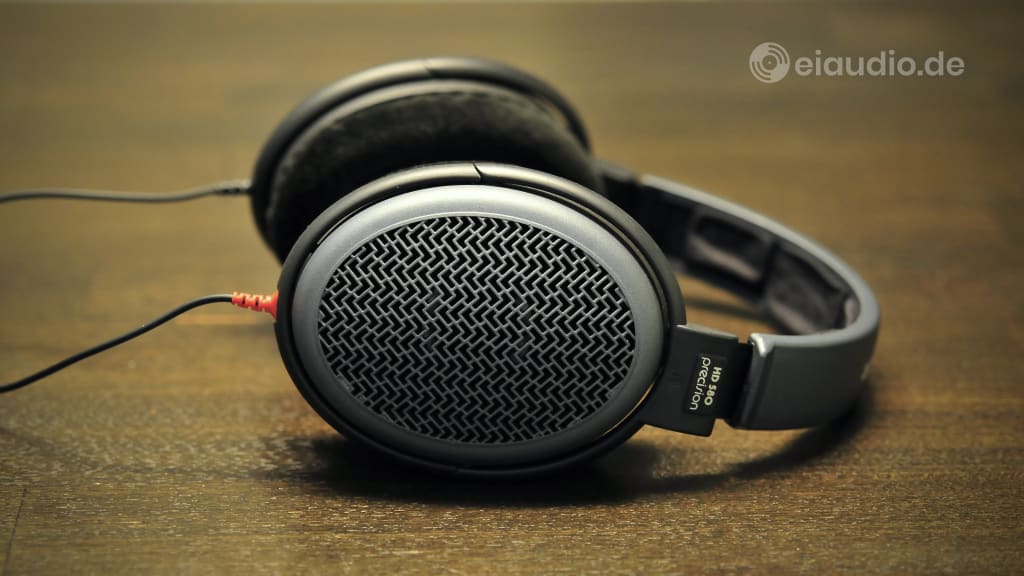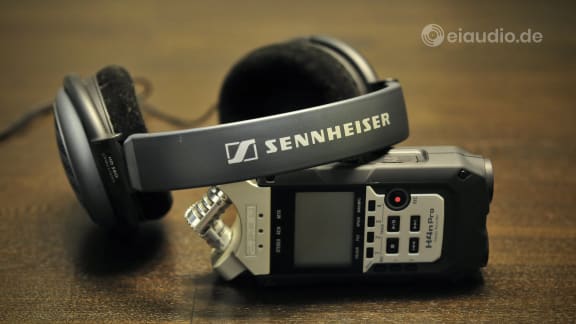Sennheiser HD 580 Precision
Published: 30/11/2021
Manufacturing date: 1993
Author: Karsten Hein
Category: Gear & Review
Tag(s): Headphones
In my recent article on the Beyerdynamic DT 990 PRO, I wrote that my reason for purchasing new headphones had been that I could not remember who I had given my old Sennheisers to. Some weeks later, I found them at my parents’s house, next to an unused field recorder. As it turned out, the Sennheisers were much older than I remembered (and had professed in my article). A faded and wrinkled receipt showed that I had bought them at Galeria Kaufhof in 1996. All the more, I was surprised to find them still in good shape, even after 25 years. And something else surprised me: Even before listening to them again, I still had a solid memory of their sound.
Before purchasing my Sennheiser HD 580s, I had listened to music with a set of closed Panasonic studio monitors that we had bought in New York during the 1980s for the pretty steep price of 250.00 USD. I remember that they had impressive bass and were able to lift the ear-pieces off your head. They also featured an otherwise decent sound. I carried them around until the cushions disintegrated and their black and flaky residue would be clinging to my hair for the rest of the day. At the time, I was reluctant to give them up. And switching to the open Sennheiser HD 580 seemed to be a sonic step back. Everything I had loved about the Panasonic headphones was gone. Instead, there was this barren new clarity, a quality that I had trouble warming up to at the time.
Perhaps this was partly due to the fact that the relatively high impedance of 300 Ohms made them more difficult to drive with the equipment I owned in the 90s. It seems that these headphones were directed at the professional market, where high impedance is less of a problem. And, since the Pioneer had been of closed design, the semi-open Sennheisers seemed far less punchy in bass. This made me miss the familiar fullness of the lower frequencies. However, dusting them off and listening to them again after so many years, with years of discerning speaker auditions having gone by, my taste in sound and music had also matured, and the Sennheisers left a much more balanced impression than they used to. I was able to see the advantages of such an open design. It all depended on the application.
On professional recording equipment, such as our Zoom H4n, the HD 580 did do quite a wonderful job in depicting voices and stage dimensions. I noticed this first when I played back a recording of my father playing the guitar. Both the guitar and my father sounded so realistic that I had to look up from the monitor to check if he had started playing again. I was amazed to find him sitting with his hands by his side, patiently waiting for me to finish my listening check. A simmilar effect happened, when I was listening to my recording of Luigi’s Snell C-IV loudspeakers playing the first song of Jörg Hegemann’s “Foot Tappin’ Boogie” album. I had set up two large-diaphragm studio mics, pressed record, and then walked across the room to turn on the CD player. Listening to this again during video production a few days later, I repeatedly looked up, fully convinced that someone was approaching me from behind. The impression was fabulously real.
When it came to voices, the Sennheiser HD 580 deserved the name ‘precision’. Tonal accuracy would have been an even better name. And this character trait did not depend so much on the equipment driving them, either. On the other hand, they were not particularly strong in terms of bass extension. For optimum bass, they required a strong dedicated headphone amp. On our T-3 Plus with GE tubes, the HD 580 showed a punchy mid-bass, but lower bass frequencies were still under-represented to the extent that it took some getting used to. At the higher end of the spectrum, the Sennheisers tended to focus on the essence only. Sadly, this meant losing some of the nuances and subtle transients of the music. This made them excellent companions for smaller recording studios to monitor the tonal balance of voices and guitars but also rather useless for genuine audiophile listening, which was perhaps not surprising given their relatively low price point.
As I found out when doing research on the specifications, there is a real HD 580 fan community out there. And, to my delight, I even managed to find a new replacement head-cushion for my Sennheisers online (not yet shown in the photos). They were well-worth keeping, if only for monitoring future studio sessions with our Zoom recorder. In this scenario, I could not imagine anything more useful.
Company History
Fritz Sennheiser set up operations in a farm house near Hanover in 1945 post-war Germany. His young start-up Laboratorium Wennebostel, or ‘Lab W’, soon became a supplier of measuring equipment to Siemens. In 1958, the company changed its name to Sennheiser electronic. Although Sennheiser’s MD 1 mic still borrowed heavily from existing microphone designs, the MD 2 mic was of the company’s own engineering. Other microphones soon followed, with the first Sennheiser wireless microphone system reaching the market in 1957. In 1960, the company introduced its famous MD 421 microphone, which is still available in stores today.
The company produced a range of successful products and soon expanded to form subsidiaries in over 20 countries. Famous headphones include the HD 25 (1988), the Orpheus electrostatic headphones (1991), the HD 800 high-end headphones (2009), and the electrostatic Orpheus successor HE 1 (2015). Both the Orpheus and the HD 800 are considered to be top-of-their-range products. At the time of writing this article, the company is run by the Sennheiser family in its 3rd generation.
Specifications:
- Driver type: single, dynamic
- Design: over-ear, semi-open
- Frequency range: 16 - 30,000 Hz (-3 dB)
- Impedance: 300 Ohms
- Sensitivity: 97 dB (1,000 Hz)
- Harmonic distortion: < 0.1 dB
- Plugs: 3.5mm + 6.3mm jack
- Weight: 260 grams
- Place of manufacture: Ireland
- Cable length: 3m
- Year(s): 1993 - 1997





